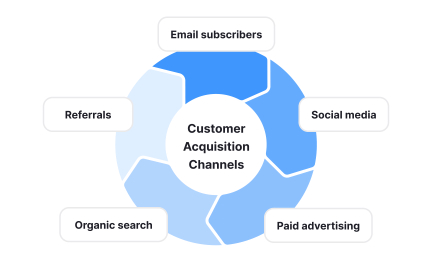Growth Product Manager
A growth product manager focuses on improving user acquisition, activation, retention, and revenue by testing and optimizing product levers.
What is Growth Product Manager?
Your product has decent features but growth stalls because traditional product managers focus on building functionality without systematic approaches to user acquisition, activation, and retention, missing opportunities to accelerate growth through experimentation and optimization.
Most companies separate product development from growth initiatives without recognizing that sustainable growth requires product thinking, missing the specialized role of Growth Product Managers who combine product management with data-driven experimentation to systematically increase key metrics.
A Growth Product Manager is a specialized PM role focused on increasing user acquisition, activation, retention, and revenue through rapid experimentation, data analysis, and cross-functional collaboration to find and scale what drives sustainable product growth.
Companies with dedicated Growth PMs achieve 45% faster growth rates, improve key metrics by 60% annually, and build significantly more valuable businesses because someone systematically optimizes every step of the user journey rather than hoping good products naturally grow.
Think about how Facebook's Growth team took them from college network to global platform, or how Airbnb's Growth PMs discovered that professional photography dramatically increased bookings through systematic experimentation.
Why Growth Product Managers Matter for Scale
Your product growth depends on random viral moments or expensive paid acquisition because no one systematically experiments with growth levers, leading to unsustainable CAC, poor retention, and missed opportunities to compound growth through product improvements.
The cost of lacking Growth PM expertise compounds through every missed optimization opportunity. You overpay for acquisition, lose users through poor activation, watch competitors grow faster, and eventually stall when obvious growth tactics exhaust without systematic improvement.
What effective Growth Product Management delivers:
Better unit economics through systematic optimization because Growth PMs improve every metric from CAC to LTV rather than accepting status quo performance.
When Growth PMs excel, products grow sustainably rather than through brute-force spending that destroys profitability while chasing vanity metrics.
Enhanced experimentation velocity and learning through rapid testing culture that discovers non-obvious growth drivers rather than implementing best practices without validation.
Improved cross-functional collaboration because Growth PMs coordinate across product, marketing, engineering, and data teams rather than growth living in silos.
Stronger product-market fit signals as Growth PMs measure and improve activation and retention rather than just acquiring users who quickly churn.
Compound growth through systematic improvements where each optimization builds on previous gains rather than one-time growth hacks without lasting impact.
Step 1: Master Growth Metrics and Analytics (Month 1)
Develop deep understanding of pirate metrics (AARRR), cohort analysis, and statistical significance rather than surface-level dashboard watching without insight.
This creates Growth PM foundation based on data fluency rather than gut feelings about what might drive growth without measurement rigor.
Step 2: Build Experimentation Framework and Velocity (Month 1-2)
Create systematic approach to hypothesis generation, test design, and rapid iteration rather than ad-hoc experiments without learning accumulation.
Focus experimentation on high-impact areas rather than testing everything equally, prioritizing based on potential metric movement and confidence levels.
Step 3: Develop Cross-Functional Influence (Month 2-3)
Build relationships and credibility across teams rather than operating in isolation, enabling resource access and implementation speed for growth initiatives.
Balance growth focus with product quality to ensure sustainable growth rather than short-term hacks that damage long-term value.
Step 4: Create Growth Loops Not Just Tactics (Month 3-4)
Design systematic growth mechanisms rather than one-off campaigns, building compounding effects where users naturally drive more users.
Step 5: Scale Successful Experiments Into Features (Month 4+)
Transform validated growth experiments into product features rather than temporary campaigns, embedding growth into product DNA rather than bolted-on tactics.
This ensures Growth PM work creates lasting value rather than temporary bumps requiring constant new tactics to maintain.
If Growth PM efforts don't improve metrics, examine whether experiments test meaningful hypotheses rather than random changes without strategic theory.
Recommended resources
Courses

UX Research

Enhancing UX Workflow with AI

Design Thinking
Lessons

Building a Product Strategy

Product Definition




